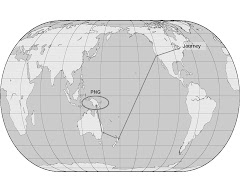The missionaries, by contrast, generally live in small, but nice homes with many – not all – modern conveniences. Most have one floor, but a few have two or walkout basements in this mountainous area. Inside, the floors are hardwood, with paneled walls that are sometimes covered with woven bamboo for decoration. Outside, the homes have spacious, well manicured lawns with gardens full of bright colored flowers, poinsettia trees and banana patches. There is often a compost pit hidden in these gardens. Since there are no garbage disposals, all biodegradable waste – fruit and vegetable peels, food scraps, egg shells, etc. -- are stored in a tightly closed plastic bucket to contain the powerful smell until they are brought to the pit. That’s not a pleasant job; by the time you’re done you might need some sawdust, too.
At night, the homes are well lit by security lights, and the unpaved, rocky streets are patrolled by PNG nationals. Andrew often greets me with a bright smile and a handshake, day or night, as he slowly makes his rounds. Safety is a high priority here. For all the idyllic notions of this being a tropical paradise, it is more of a paradise lost. And just like the one in Milton’s story, it is a paradise in need of re-creation by the Spirit of God.
In many respects, the problems we have in the cities of America are problems here, too. Drugs. Crime. Rape. Gangs (of a sort). These are all present here – even to the extent that missionaries typically keep their doors locked during the evening hours to prevent home invasions even while they’re awake.
All of this points to Paul’s assertion that “there is no one righteous, not even one.” (Romans 3:10) This tendency to sin is built into our nature. But even the most hardened of sinners have a hope beyond themselves in the transforming power of the Holy Spirit. I have seen proof of it numerous times during this trip, where a life turned over to Christ is miraculously changed and habits of death are replaced with life. “Therefore,” as Paul also says, “if anyone is in Christ, he is a new creation; old things have passed away; behold, all things have become new.” (2 Corinthians 5:17)




